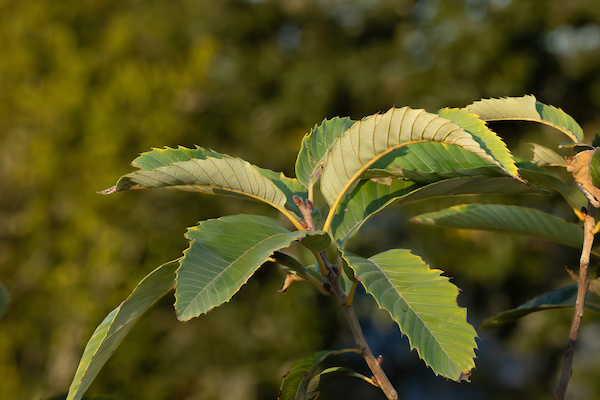As soon as a typical sight, Missouri’s native chestnut tree, Castanea ozarkensis, supplied meals for individuals and animals in addition to wooden for furnishings and musical devices. Now, the tree, additionally referred to as the Ozark chinquapin, is unfamiliar to most Missourians.
Within the early 20th century, chestnut blight worn out hundreds of thousands of Castanea ozarkensis. The remaining timber develop solely to a fraction of their former massive stature and produce few viable seeds.
However there may be hope for this as soon as beloved tree, because of efforts from the Ozark Chinquapin Basis, with assist from the Missouri Botanical Backyard, to establish and cross blight-resistant remnant timber with related survivors and plant them within the chinquapin’s historic vary.

What’s the Ozark chinquapin?
Castanea ozarkensis, or the Ozark chinquapin, is a tree native to the Ozark-Ouachita Mountain areas of Missouri, Arkansas and Oklahoma. It will also be present in Alabama, Georgia, Mississippi, Japanese, and some others scattered areas within the southeastern US.
Earlier than blight, the tree was as soon as a typical upland forest species, and the drought-tolerant hardwood timber grew as much as 65 toes tall and a couple of–3 toes in diameter. Now, the timber now to be 20–30 toes tall. It blooms from Could to June, producing yellowish-white flowers and sprout inexperienced rectangular leaves that flip a shade of yellow within the fall.
The tree produces extremely nutritious, sweet-tasting edible chestnuts.

Chestnuts as a meals supply
Ozark chestnuts are edible uncooked or roasted. They will also be utilized in baked items. The chestnuts had been as soon as a meals supply for Native People and early settlers. Indigenous individuals used them in steamed corn bread dishes much like tamales that usually contained beans and nuts.
Native wildlife, together with squirrels, chipmunks, deer, and birds, loved the candy chestnuts as nicely.

Medication and Music
Ozark folklore archives point out that the Ozark chinquapin had historic medical makes use of, too, together with a tea constituted of boiling leaves or nuts to treatment a cough, chilly, or sore throat. The hardy wooden of the chinquapin was used extensively for furnishings and fences as a consequence of its rot resistance. Wooden was additionally used to create musical devices, together with fiddles and banjoes.
Learn extra about Ozark chinquapins and its musical traditions. >

What occurred to the Chinquapin inhabitants?
Cryphonectria parasitica, generally referred to as Chestnut blight, arrived within the U.S. from imported chestnut timber from Asia within the 1800s. The illness was first recognized in New York in 1904, based on the Ozark Chinquapin Basis, and reached the Ozark space within the Sixties. Inside a decade, Ozark Hills “had been suffering from the lifeless, rot-resistant carcasses of Ozark chinquapin timber that reached as much as 65 toes excessive”. The blight worn out all however just a few massive mature tree.
Whereas there are nonetheless uncommon massive timber all through the vary, most chinquapins that survive at present are small and produce only a few seeds wanted to repopulate the species.

Combating for the long run
The Ozark Chinquapin Basis, or OCF, was based in 2007 with a imaginative and prescient of restoring the native tree again to southern forests and woodlands. Backyard Scientist Matthew Albrecht, who serves as a science advisor for OCF, has partnered on this work in varied methods.
The Backyard’s Middle of Conservation and Sustainable Improvement, or CCSD, helped assist the OCF’s blight-testing program to display screen timber for blight resistance. The Backyard grew dozens of Chinese language and American chestnut seedlings, which served as benchmarks for evaluating blight resistance in Ozark chinquapin timber and OCF workers contaminated the leaves of all three species with blight to find out which Ozark Chinquapin timber are extra blight resistant and ought to be used for OCF’s cross pollination work.
The tree can also be one of many species CCSD will work on in a brand new undertaking, funded by a grant from the Institute of Museum and Library Providers, that can look at adaptive and impartial genetic and phenotypic variation in botanical backyard residing collections.
OCF is amassing seeds from timber within the wild this autumn for this analysis undertaking. Outcomes from this analysis will assist inform ongoing efforts to revive the species to its indigenous vary.

On the Backyard
The Backyard added two Ozark chinquapin to its residing assortment in 2023. That is a part of the Backyard’s conservation horticulture strategy, which focuses on conserving threatened crops inside landscapes in botanical gardens.
“This species checks a variety of bins for our residing assortment and the brand new panorama, because it was not but represented on grounds, it’s threatened, it’s a stunning and attention-grabbing tree, and it has a great deal of instructional potential,” defined Becky Sucher, Senior Supervisor Dwelling Collections.
She hopes that story of the Ozark chinquapin can inform guests concerning the penalties of introducing non-native pests and pathogens to our native flora, how pests and pathogens are launched, the biology of an infection, financial and ecological impacts, administration and conservation efforts to regulate illness, and extra.
As work continues, it’s doable further Ozark chinquapin timber might be added to the Backyard’s panorama, or at Shaw Nature Reserve.
For now, search for the 2 timber out within the panorama outdoors of the Jack C. Taylor Customer Middle.
Catherine Martin
Senior Public Info Officer
Many because of CCSD Director Matthew Albrecht, Senior Supervisor of Dwelling Collections Becky Sucher, Senior Vice President, Horticulture & Dwelling Assortment Andrew Wyatt, Backyard Scientist Wendy Applequist, and Backyard Scientist Kate Farley for skilled data supplied for this submit.
